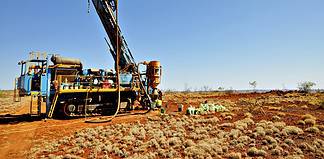By Samantha James
4 November, 2015
MANY junior exploration and mining companies have struggled with volatile and declining commodity prices in recent years, but a new survey claims the fight may be easing for gold juniors.
The 2015 Grant Thornton Junior Mining and Exploration Survey (JUMEX 2015) found 63 per cent of mining executives regarded gold as the brightest investment opportunity in 2016, followed by copper (50 per cent), zinc (36 per cent) and nickel (23 per cent).
“This will be a welcome ray of hope for a significant portion of junior miners given the extremely challenging conditions that persist in the sector,” Grant Thornton Australia national head of energy and resources Holly Stiles said.
“Whilst there are companies who are achieving success – mainly in developing projects – the vast majority of junior miners are facing ongoing cash constraints, continuing falls in share prices, volatile commodity prices and disgruntled shareholders, which are all taking their toll.”
The survey found that explorers were exploring less and less each year due to ongoing commodity price woes, lack of funding, regulatory challenges, and low employment outlook.
However, a there was a growing level of collaboration across the broader industry, mainly between miners and service companies, as industry participants looked for ways to save money.
“To grow value in an extended period of market downturn it is imperative that junior miners maximise every cent of expenditure and be ever more creative in structuring solutions to fund and develop their projects,” Ms Stiles said.
The survey found that 50 per cent of junior miners were planning a fund raising within six months and 29 per cent had a cash balance of less than $500,000.
As a consequence, competition for capital was extreme and failure was largely expected, with increased business consolidations and exits from the resources sector through back door listings, according to JUMEX 2015.
The slightly more positive positioning for the gold industry, particularly in Australia, was reflected at the Committee for Economic Development of Australia’s (CEDA) WA Annual Resources Review.
AngloGold Ashanti Australia senior vice president Michael Erickson told investors that “in Australia gold is one of the brighter lights in a somewhat gloomy sector”.
This was despite a significant drop in the gold price from the 2011 high of US$1900 per ounce of gold to a low of just under US$1100/oz of gold in August 2015.
“It’s quite a dramatic change and no doubt we’re in a different phase of the gold market, one that’s likely to stay with us at least for the medium-term,” he said.
However, he said gold price drivers, including supply and demand, global economic conditions and Central Bank policy, had united analysts in an outlook that was “subdued but not overly bearish” at an average of US$1200/oz of gold for fiscal 2016.
Mr Erickson said that gold equity markets and investor confidence had increased in the gold sector since August 2015, with a “more positive feel” at conferences and renewed investment interest.
“Gold equities that were just abandoned by investors when the price fell sharply in 2013 are now seeing support as funds return slowly to the sector,” he said.
Mr Erickson said in Australia miners and explorers were reaping the benefits of currency leverage as the Australian spot price had risen.
“The Australian spot price has risen by more than 25 per cent in the past year and Macquarie Bank researchers are forecasting an average gold price in Australia of US$1670/oz of gold in fiscal 2016,” he said.
“This, along with operational improvements, has enabled Australian producers to generate strong cash flow and accelerate repayment of debt.
“It has also seen the Australian gold sector outperform the others, with the ASX All Ordinaries Gold Index rising by almost 50 per cent this year.”
However, Mr Erickson said that despite the improvement in the market in the second half of calendar 2015, the fight was not over.
“As an industry we mustn’t be lulled into a false sense of security by the benefits we’re deriving from currency weakness,” he said.








































